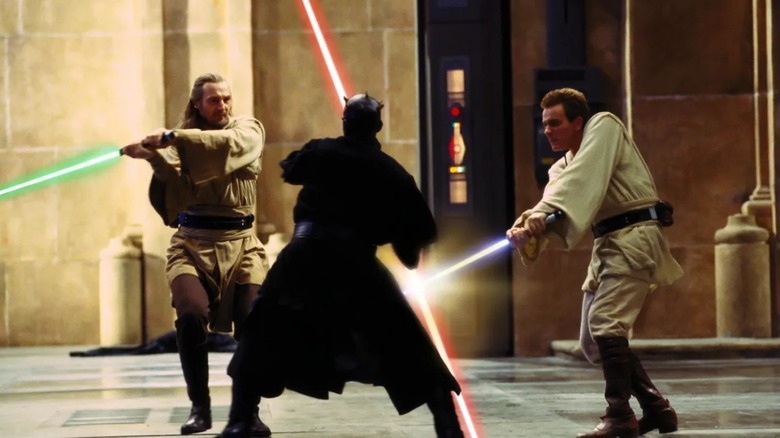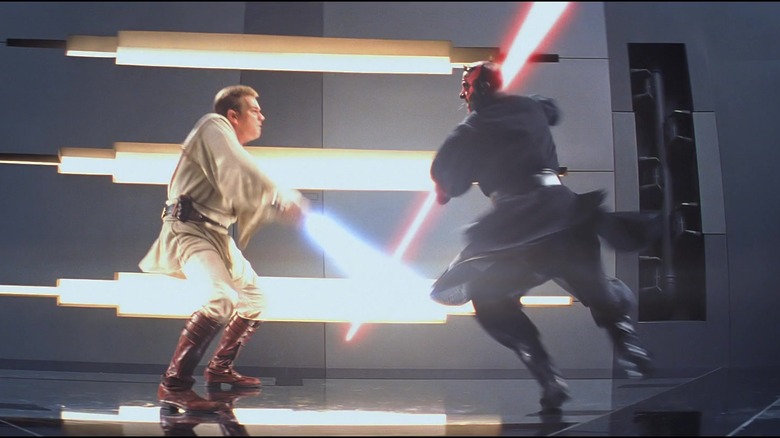How The Star Wars Prequels Pulled Off Jedi Jumps And Flips Without Any Wires
The "Star Wars" prequels changed the game for the franchise, for better and worse. For one, they interrogated the idea of the Jedi as noble warrior monks by making them misguided space cops. But it also forever changed the way we look at lightsaber fights.
The original trilogy had memorabe lightsaber duels and cool stunts, of course, but the prequels reinvented them by turning the duels from samurai-esque, Mexican stand-offs into Shaolin monk fights with elaborate acrobatics. Characters jump around, twirl, and swing their lightsabers around with great intensity. Even if the sequel trilogy didn't really do all the acrobatics, they also featured more elaborate stunts in the duels (like the fantastic throne room fight in "The Last Jedi").
Unsurprisingly, making those stunts wasn't an easy task. In the official "The Making of Star Wars, Episode I – The Phantom Menace" book by Laurent Bouzereau and Jody Duncan, stunt coordinator Nick Gillard explained that, next to the complicated sword movements — which only got more complicated with each of the films — they also had to figure out how to do the many jumps and acrobatics. Not only that, but the stunts had to be done without wires, because Gillard "never thought the moves on wires looked believable."
To achieve this, they didn't simply resort to CGI doubles. Instead, the stunt team used nitrogen air rams, pneumatic rams that are typically used to simulate explosions in movies, but if aimed sideways and the explosion is removed, it pushes out a huge gust of air.
"With air rams, the performers looked as if they were flying, and the landings were hard and realistic," Gillard said. "With wires, they looked like they were floating through the air. It wasn't as powerful a move."
Jedi somersaults
These air ramps were involved in some of the best stunts in the whole movie, like Darth Maul's aerial backward somersault, which actor Ray Park performed by traveling 40 feet across the stage, according to the "Star Wars: The Making Of Episode I – The Phantom Menace" book.
In a separate interview with Vulture for a retrospective on "The Phantom Menace," Gillard talked about the final big stunt of the movie, the moment Obi-Wan jumps from a huge pit, does a somersault, then slashes Maul in half, seemingly killing him (until he came back, of course).
Because of how intricate and difficult it is to have a stunt actor, let alone the star of the movie, do this stunt and actually land on his feet, a different solution was required, to shoot the sequence backward. Park and Ewan McGregor's stunts performed the sequence in reverse, with Obi-Wan sewing Daul back together with his lightsaber before jumping into a pit at the end. A bit less glamorous but impressive nonetheless.
Even without the acrobatics, the lightsaber duels were still fast-paced, intricate dance choreographies. "Revenge of the Sith" in particular has so many movements that you wouldn't even notice all of them without pausing and going frame by frame. Much of this wasn't even in the script, like Dooku's death by decapitation.
Though this might create a disparity in the quality of lightsaber action between the original trilogy and the more recent "Star Wars" movies, there's something to love about every duel in any era.

